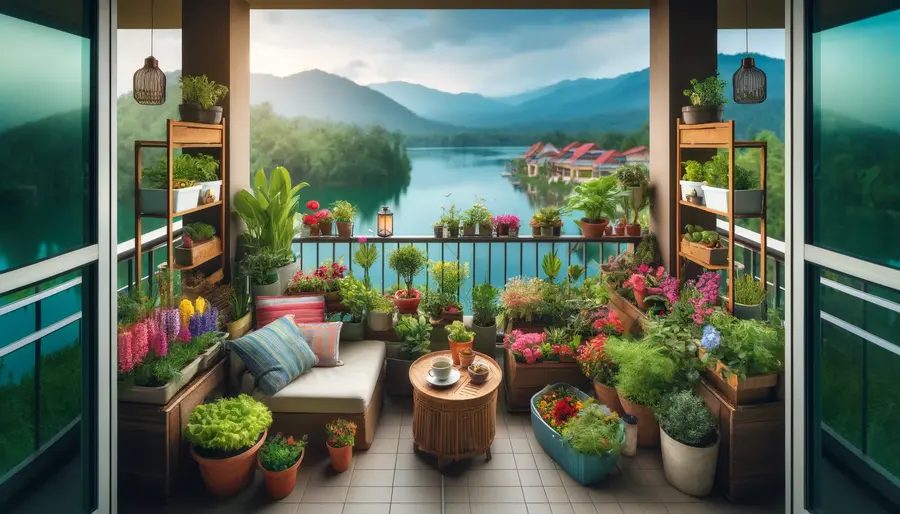
What is Apartment Balcony Gardening?
Apartment balcony gardening is the practice of cultivating plants in small outdoor spaces of apartment buildings. It allows urban dwellers to grow flowers, herbs, vegetables, and even small fruit trees. By using containers, vertical structures, and optimizing sunlight, one can transform a balcony into a productive and aesthetic green space.
🌻Balcony Gardens: From Vision to Reality
Ever looked out at your apartment balcony and imagined it bursting with vibrant greens and colorful blooms?
Welcome to the world of apartment balcony gardening! It’s where concrete meets chlorophyll, and even the tiniest spaces come alive. Ready to turn that vision into reality?
🌿 An Introduction to Apartment Balcony Gardening
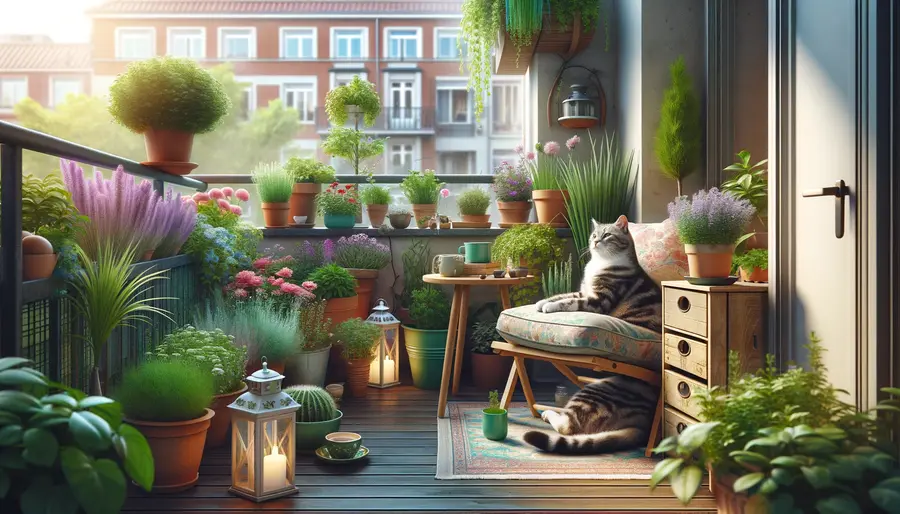
So, you’ve got a balcony and a dream of turning it into a gardening haven, right? You’re in the perfect spot. In this guide, we’ll journey through the ins and outs of apartment balcony gardening.
From choosing the right plants to advanced techniques, we’ve got it all covered. Ready to make your balcony the talk of the town? Let’s get started!
Balcony gardening transforms a small space into a green oasis. It’s the perfect place for apartment dwellers to connect with nature.
🌆 Unlocking the Potential of Your Urban Garden
Not everyone has room for a sprawling backyard, but that doesn’t mean you can’t create something special. Even the smallest balcony holds untapped potential.
With a bit of creativity and care, your space can become a lush, peaceful retreat above the city noise. Whether you’re growing herbs, flowers, or veggies, your garden is what you make it.
Ready to reimagine your space? Unlock the potential of your urban garden and turn your balcony into something extraordinary.
🏙️ The Rise of Balcony Gardening in Cityscapes
As cities grow and green space shrinks, more people are turning to balconies to reconnect with nature. What started as a hobby has become a quiet movement, one balcony at a time.
Balcony gardening is reshaping urban living, bringing color, calm, and cleaner air to once-grey spaces.
It’s proof that even in dense city environments, we still crave nature, and we’re finding creative ways to make room for it.
🧱 Balcony Basics: Starting Your Green Balcony Garden
Starting your balcony gardening journey might feel overwhelming, but it all begins with a few simple steps. Understanding the basics sets you up for long-term success.
Take a close look at your space:
- 🌞 Do you get lots of sun or mostly shade?
- 🏗️ How much weight can your balcony safely support?
- 🌦️ What’s your local weather pattern like?
If you’re working with a sunny balcony in India, we’ve got great plant picks to get you started.
Once you understand your environment, you can choose the right tools, containers, and plants to build a thriving garden that reflects your style.
🌡️ Understanding Your Balcony’s Microclimate
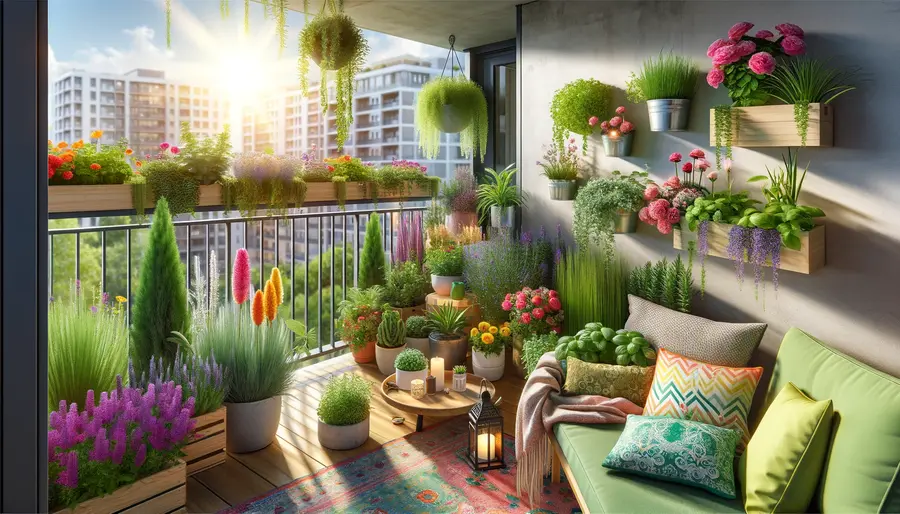
Your balcony has its own mini climate, different from the street below or even the neighbor next door. These small differences can make or break your plant choices.
- 🧭 Which direction does your balcony face: north, south, east, or west?
- 🏢 Are there nearby buildings that block or reflect sunlight?
- 🌬️ Does your balcony trap heat or stay breezy and cool?
- 🔩 Is it made of concrete, tile, or metal that affects temperature?
The better you understand your balcony’s microclimate, the easier it is to pick plants that will truly thrive in your space.
🏗️ Laying the Foundations
Before the flowers bloom and the herbs grow, every great balcony garden starts with a solid setup. Think of your space as a blank canvas, and now’s the time to prep it for something beautiful.
From tools to layout tips, this foundation guide will help you understand your balcony’s quirks and strengths. It’s not just about planting. It’s about creating the right environment for plants to thrive.
With a little prep and the right setup, your garden will have a strong start and an even better chance to grow.
🧰 Essential Tools for Every Balcony Gardener
When it comes to apartment balcony gardening, having the right tools makes balcony gardening easier and more enjoyable. Here’s what to keep handy if you want healthy plants and smooth maintenance.
- 🪴 Self-watering pots – Help regulate moisture and reduce daily watering.
- 🌿 Trellises or plant supports – Perfect for climbing plants and vertical gardening.
- ✂️ Ergonomic hand tools – Include pruners, trowels, and hand forks for tight spaces.
- 🧤 Gardening gloves – Protect your hands while planting or pruning.
- 🧹 Compact watering can or hose – Look for long spouts to reach tight spots.
- 🪟 Space-saving planters – Use stackable or rail-mounted containers to maximize room.
🪴 Choosing Pots for Limited Balcony Space
The right containers can make or break your garden. Choose pots based on plant needs, weight limits, and your balcony’s style.
- 🧱 Terracotta pots – Breathable and classic but heavy and breakable.
- 💧 Self-watering pots – Ideal for busy schedules or sunny balconies.
- 🌱 Plastic containers with drainage holes – Lightweight and easy to move around.
- 🪟 Rail-hanging pots – Save floor space and add visual height.
- 🔄 Repurposed containers – Budget-friendly and creative (just drill drainage holes).
🪴 The Right Soil for Apartment Balcony Gardening
Your plants’ success starts with what’s beneath them. For container gardens on balconies, lightweight, well-draining soil is a must.
Two common choices are peat-based potting mixes and coco coir. While both get the job done, more balcony gardeners are picking coco coir for good reason. Let’s compare them side by side and see which one fits your setup best.
🪴 Peat-Based Potting Soils vs. Coco Coir Compared
Choosing the right growing medium is essential for healthy plants and sustainable gardening. Here’s how peat and coco coir stack up side by side:
🌱 Composition and Sustainability
- Peat-Based Soils: Made from harvested peat moss, which damages natural bog ecosystems and releases stored carbon.
- Coco Coir: Made from coconut husks, a renewable, byproduct material that’s eco-friendlier and widely available.
💧 Water Retention and Drainage
- Peat: Retains water well but becomes difficult to re-wet when dry. Risk of root rot if it stays soggy too long.
- Coco Coir: Excellent balance of water retention and drainage. Lighter than peat, making it great for balconies.
⚖️ pH Level and Nutrient Content
- Peat: Naturally acidic, which may not suit all plants. Often needs lime added to adjust pH.
- Coco Coir: Neutral pH makes it more plant-friendly, but it lacks nutrients, so you’ll need to fertilize.
🔁 Reusability and Longevity
- Peat: Breaks down quickly and compacts. Typically a one-time-use medium.
- Coco Coir: Holds structure after a full season and can be reused with added nutrients.
🌎 Environmental Impact
- Peat: Non-renewable and harmful to ecosystems. Peat bogs take centuries to recover after harvesting.
- Coco Coir: Uses waste from coconut production and reduces landfill input. More sustainable overall.
✅ Conclusion
Both options can work, but coco coir wins for sustainability, reusability, and balcony practicality. If you’re aiming for greener gardening, coco coir is the better bet for both your plants and the planet.
💸 Budget Balcony Gardening: Save & Grow
You don’t need fancy gear or pricey pots to start a thriving balcony garden. With a little creativity, you can grow big on a small budget.
- 🪴 Repurpose what you have: Old buckets, mugs, or even boots make quirky, functional planters.
- 🌱 Start from seed: Seeds are cheaper than buying young plants, and more rewarding, too.
- 🧤 DIY tools and decor: Skip the store and make your own labels, stands, or trellises.
- 🪟 Use window boxes or crates: They’re a budget-friendly way to kick off your balcony setup.
- ⏳ Patience pays off: Even a modest setup can grow into something lush with time and care.
🎨 Designing Your Balcony Garden
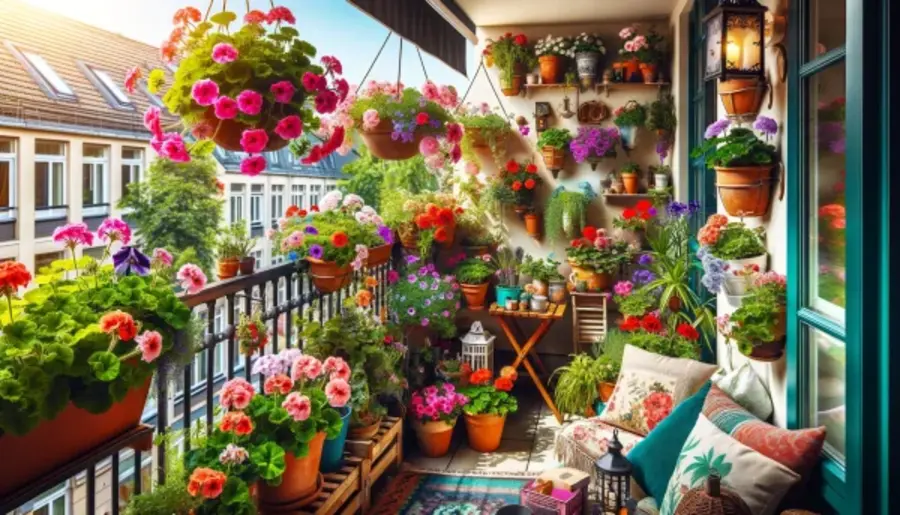
Now that your foundation is in place, it’s time to shape your balcony into something special. Designing your apartment balcony garden is where personality meets practicality.
Whether you’re dreaming of a cozy floral nook or a mini produce patch, the right layout will help you make the most of your space, without giving up comfort or style.
📏 The Art of Maximizing Limited Space
Balconies don’t offer much room, but with smart design, small spaces can do big things.
- 🌿 Vertical gardening lets you grow up instead of out. Use railings, walls, and ceilings to your advantage.
- 🪴 Wall-mounted pots and stackable shelves increase your planting area without taking up floor space.
- 🏗️ Trellises and climbing plants add height, color, and structure in tight spots.
- 📐 Think of each level, floor, railing, and wall as usable square footage for different plant types.
🌿 Creating Vertical Beauty: Going Beyond the Floor
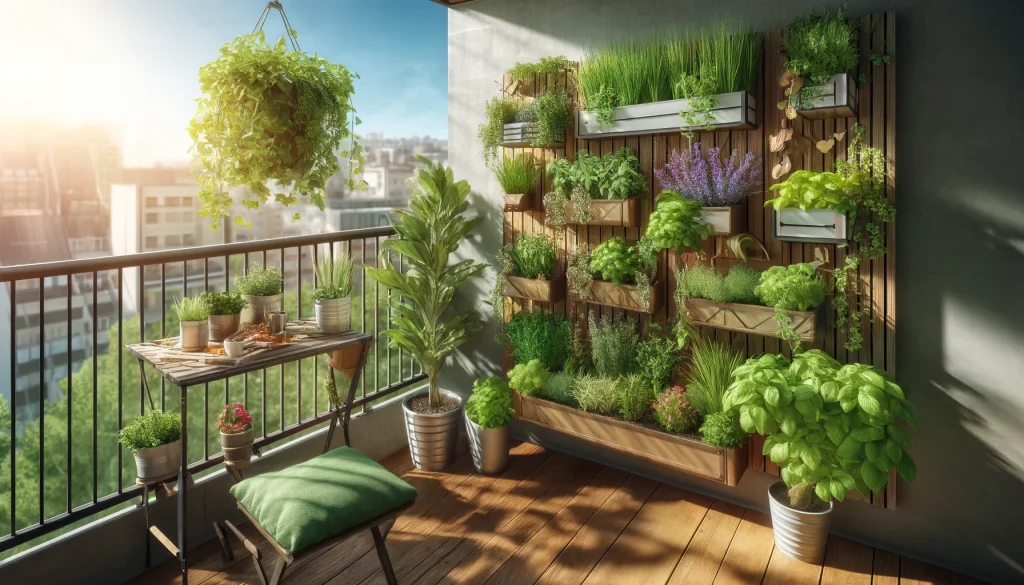
Your floor isn’t the only place where plants can thrive. Vertical setups can bring new life, layers, and beauty to your balcony garden.
- 🪴 Hang pots from railings or ceilings to add greenery at every level.
- 🧱 Use vertical planters to create a living wall that doubles as privacy and décor.
- 🌱 Train climbing plants like jasmine or ivy to grow up trellises or balcony railings.
- 🌼 Combine hanging plants with upright containers for a cascading, layered effect.
🎯 Balcony Themes: From Edible Gardens to Floral Paradises
Your balcony garden can reflect your personality, passions, and even your cooking style. Choosing a theme helps tie everything together visually and functionally.
- 🥗 Edible Garden: Grow herbs, veggies, and compact fruit trees for balcony-to-table freshness.
- 🌸 Floral Paradise: Fill your space with colorful blooms for beauty, fragrance, and pollinators.
- 🌿 Zen Garden: Create calm with bamboo, smooth stones, and soothing green plants.
- 🌴 Tropical Retreat: Use bold foliage, hanging palms, or colorful crotons for an island vibe.
- 🍁 Seasonal Themes: Rotate annuals and accents throughout the year to keep things fresh.
☀️ Maximizing Sun on a Tiny Balcony
Light is everything when it comes to plant growth. Making the most of your balcony’s sunlight can mean the difference between thriving and barely surviving.
- 🧭 Track the sun’s path across your space throughout the day.
- 📦 Rearrange pots to catch the most light as seasons or angles change.
- 🔁 Rotate containers weekly for even growth on all sides.
- 🔍 Use reflective surfaces (mirrors, light-colored walls) to bounce extra light.
- 🌤️ Place sun-loving plants in full sun and shade-preferring ones in indirect areas.
🌿 Vertical Solutions for Small Balconies
Running out of floor space? Go up. Vertical setups help you fit more plants without feeling cramped, and they add style too.
- 🪜 Repurpose ladders as tiered plant stands for a rustic, space-saving display.
- 🪴 Wall-mounted shelves work great for herbs, flowers, or succulents in small pots.
- 🌸 Hanging baskets from the ceiling or railings keep foliage eye-level and off the ground.
- 🌱 Climbing plants like ivy or jasmine thrive on trellises or string supports.
- 🎯 Mix vertical and horizontal levels to create depth and make your garden feel layered and lush.
🪴 Choosing the Right Plants
Here’s where the real magic starts to happen! Picking the right plants is like choosing the cast for a blockbuster movie.
You want stars that’ll shine and supporting roles that complement them. Whether your balcony is bathed in sunlight or tucked away in the shade, we’ll help you find the perfect plants to make your garden flourish.
When it comes to balcony gardening, not all plants are created equal. The secret lies in selecting plants that match your balcony’s conditions and your personal preferences.
☀️ Selecting Plants for Sun-Kissed Balconies
For those lucky enough to have balconies bathed in sunlight, the plant world is your oyster. With 4–6 hours of direct sun daily, you can grow an impressive variety of plants that love the heat.
Sun-loving plants don’t just tolerate the sun, they thrive in it. Picture a balcony full of tomatoes ripening on the vine or tall sunflowers tracking the light all day long.
These plants flourish under full exposure, turning your outdoor space into a sun-kissed sanctuary of growth, flavor, and color.
- 🍅 Tomatoes – perfect for pots or grow bags
- 🌿 Basil – thrives in full sun with regular water
- 🌻 Sunflowers – tall, cheerful, and heat-tolerant
- 🌼 Marigolds – repel pests and bloom nonstop
- 🌺 Geraniums – bold flowers that love the heat
- 🌱 Rosemary – a woody herb that prefers dry soil
- 🌵 Succulents – ideal for hot, dry balconies
- 🌶️ Peppers – compact and productive in containers
- 🍓 Strawberries – love sunny rail planters
- 🌼 Petunias – colorful blooms that last all season
🌤️ Thriving Flora for Shaded Balconies
Not every balcony gets full sun, and that’s okay. Many plants prefer the cooler, softer light found in partial to full shade. These options will still give you color, texture, and fresh harvests.
- 🌿 Ferns – lush greenery for a tropical vibe
- 🌱 English ivy – cascades beautifully from pots or railings
- 🥬 Leafy greens – lettuce, spinach, and kale thrive without direct sun
- 🪴 Caladiums – colorful foliage perfect for shade
- 🌸 Impatiens – blooms well in cooler corners
With the right choices, a shaded balcony can be just as rewarding and beautiful as a sunny one.
🍋 The Best Compact Fruit Trees for Elevated Gardens
You don’t need a backyard orchard to grow fresh fruit. Compact and dwarf fruit trees are perfect for balconies and patios. Just give them sun, a deep container, and regular care.
- 🍒 Dwarf cherry or apple trees – ideal for pots with strong root support
- 🍋 Patio lemons or limes – produce fruit year-round in warm climates
- 🫐 Compact blueberries – need acidic soil and love morning sun
- 🍑 Miniature peaches or nectarines – fragrant and productive
- 🍊 Calamondin oranges – ornamental and edible citrus for containers
With the right variety, your elevated garden can deliver sweet rewards just steps from your kitchen.
🌼 Small Space, Big Blooms: Flower Choices
You don’t need much room to make a big visual impact. With the right flower choices, even the smallest balcony can be bursting with color and life.
- 🌼 Marigolds – bold orange and yellow blooms that repel pests
- 🟣 Pansies – great for cooler weather with soft, layered petals
- 🌺 Petunias – long-lasting color and a favorite for balcony boxes
- 🌸 Geraniums – classic containers full of vibrant blooms
- 🌻 Zinnias – easy-care flowers with vivid hues
It’s all about choosing flowers that pack a punch and keep your balcony garden cheerful season after season.
🌿 Balcony Herb Gardens: A Fresh Approach
If you’re looking for a functional yet beautiful garden, herbs are the way to go. They’re compact, versatile, and easy to grow even for beginners.
These hardy plants thrive in small containers and reward you with bold flavors and fresh scents just steps from your kitchen:
- 🌱 Basil – perfect for sunny spots and Italian dishes
- 🌿 Rosemary – low-maintenance with a woody, fragrant touch
- 🍃 Mint – fast-growing and great for teas and cocktails
- 🌿 Cilantro – loves cooler temps and bright light
- 🍋 Lemon balm – adds citrusy aroma and attracts pollinators
With just a few small pots, you can boost every meal with garden-fresh flavor, right from your balcony rail.
🌙 Nighttime Balcony Gardens: Moon Plants
Some plants prefer the spotlight of the moon. These nighttime bloomers open as the sun goes down, filling your balcony with quiet beauty and soft scent after dark.
- 🌕 Moonflower – large, glowing white blooms that open at dusk
- 🌼 Evening primrose – yellow flowers with a sweet nighttime scent
- 🌸 Night-blooming jasmine – intensely fragrant after sunset
- 🧄 Tuberose – tall spikes with strong evening fragrance
Pair these with soft solar lights or fairy string lights, and your balcony becomes a peaceful retreat for warm evenings and winding down.
Choosing plants that match your space and conditions is the key to a healthy, low-stress balcony garden. Think of it like casting the perfect crew: sun lovers, shade fans, fresh herbs, or evening bloomers. You’ve got options.
Whether your space is sunny, shady, or a mix of both, there’s something that will thrive on your balcony. Let’s explore your options.
🧰 Maintenance and Care
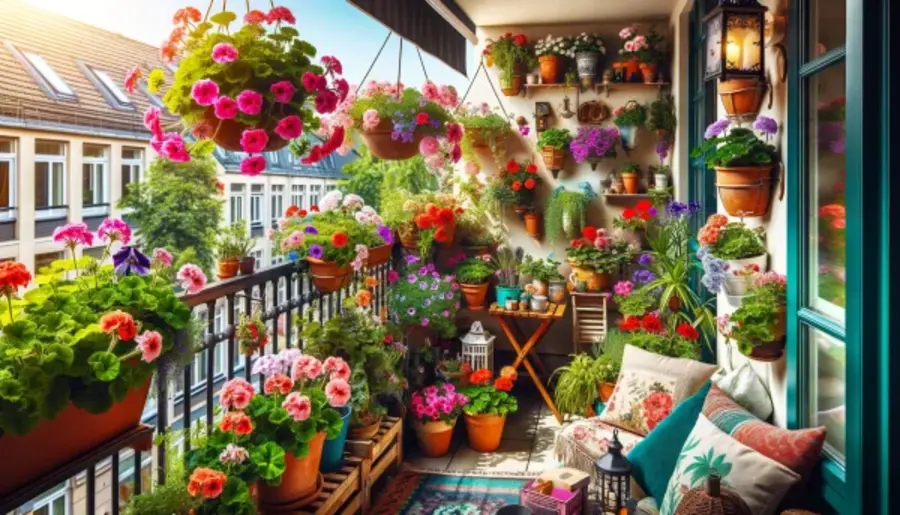
Now that your balcony garden is growing, it’s time to keep it thriving. A little ongoing care goes a long way, just like with any living thing.
This section covers the essentials: watering routines, pest control, seasonal upkeep, and more. Think of it as your plant care cheat sheet for keeping things green, happy, and stress-free.
A thriving balcony garden is a result of regular maintenance. This means routinely checking the soil, pruning dead or overgrown branches, rotating plants to ensure even growth, and regularly inspecting for pests.
It’s like a regular health check-up but for your plants. With a bit of attention and love, your balcony garden can remain a lush, vibrant space, offering solace and beauty in the heart of the city.
Regular pruning, checking for diseases, and ensuring good drainage can keep your garden thriving.
Your garden doesn’t need to be high-maintenance, but it does need consistency. The right care keeps plants blooming, herbs tasty, and veggies productive.
💧 Watering Wisdom: Keeping Plants Hydrated
Water is essential, but balance matters. Too much or too little can stress your plants, especially during summer heat. The goal? Consistent moisture and smart tools that help you stay on track.
- 💦 Use self-watering pots to keep moisture steady with minimal effort
- 🌞 Check plants more often during heatwaves, they can dry out fast
- 🪣 Water early in the morning or late evening to reduce evaporation
🚿 Balcony Watering: Tips and Tricks
Watering might seem simple, but smart techniques make a big difference, especially in a small space where every drop counts.
- 🌿 Install drip irrigation to deliver water directly to roots with less waste
- 🪴 Use a watering can with a long spout for tight corners and small pots
- 👆 Check soil moisture regularly. Water only when the top inch is dry
- ⏳ Avoid daily watering unless your plants truly need it
🐛 Guarding Against Pests: Natural Solutions
Pests can show up even on the cleanest balcony. Before reaching for harsh sprays, try natural options that protect your plants without harming you or beneficial bugs.
- 🥚 Crushed eggshells around the base deter slugs and snails
- 🧄 Garlic or chili sprays can keep aphids and soft-bodied pests away
- 🌿 Strong-smelling herbs like mint or basil may repel insects naturally
🛡️ Safe Pest Control for Balcony Plants
If pests persist, don’t worry, there are still plant-safe, chemical-free solutions that work well in containers.
- 🪴 Neem oil spray works against mites, aphids, and whiteflies
- 🧼 Insecticidal soaps break down pests without harming your plants
- 🔍 Inspect regularly, catching issues early makes them easier to manage
🍂 Seasonal Care: Adapting to Changing Weather
Plants respond to seasonal shifts just like we do. A little adjustment with the weather goes a long way toward keeping your balcony garden healthy all year long.
- 🧣 Add mulch or move pots closer together for warmth in colder months
- 💧 Cut back on watering during cooler, slower-growing seasons
- 🌱 Fertilize in spring as plants enter their active growth phase
- ☀️ Rotate or reposition containers with the changing sun angle
Stay observant and flexible. Your plants will let you know what they need as the seasons change.
🌦️ Weatherproofing Your Balcony Garden
Balcony gardens are often exposed to more intense elements, and wind, sun, and rain can all take a toll. A few simple steps can protect your plants and keep your setup secure year-round.
- 🏋️♀️ Use weighted pots or secure planters to prevent tipping in strong winds
- 🌞 Hang shade cloths or use light curtains during extreme heat
- ☔ Add rain guards or screens to keep heavy downpours from damaging foliage
💨 Protecting Balcony Plants from Wind
Wind can cool plants and keep pests away, but too much of it can cause stress or damage. Create a buffer zone with natural or decorative elements.
- 🎐 Wind chimes help break up airflow while adding charm
- 🎋 Bamboo screens or lattice panels reduce gust impact
- 🌿 Use tall or dense plants as living windbreaks
🚀 Advanced Balcony Gardening Techniques
Once you’ve nailed the basics, it’s time to level up your balcony garden. Why settle for good when it can be stunning, productive, and even more fun?
This section dives into creative techniques from moon gardens to compact composting setups that will help your space thrive in new ways.
You can also consider adding some evergreen balcony plants for year-round color, structure, and visual interest.
As your confidence grows, these advanced strategies will help you maximize space, boost plant health, and make your balcony garden even more rewarding.
💮 The Magic of Moonlit Gardens: Night-Blooming Plants
🌙 The Magic of Moonlit Gardens: Night-Blooming Plants
There’s something captivating about a garden that comes alive after dark. Night-blooming plants add fragrance, movement, and mystery to your balcony when the sun goes down.
- 🌕 Moonflowers – large, glowing white blooms that open at dusk
- 🌼 Evening primroses – yellow flowers that bloom at twilight
- 🌸 Night-blooming jasmine – sweet scent and pollinator-friendly
- 🧄 Tuberose – strong fragrance, perfect for evening ambiance
These plants don’t just look beautiful. They attract moths and other nocturnal pollinators, turning your balcony into a peaceful nighttime retreat.
🔁 Rotating Plants for Continuous Blooms
Want color and harvests all year? Rotating your plants by season is a smart way to keep your balcony vibrant and productive without burning out yours or theirs.
- 🌸 Start spring with pansies, violas, or snapdragons
- 🌞 Swap in sun-loving flowers or herbs during summer
- 🍂 Add mums, kale, or ornamental peppers for fall color
- 🌿 Use hardy evergreens or winter herbs like thyme for colder months
This strategy ensures your space always has something blooming or ready to harvest, and it keeps things fresh for you too.
🍃 Seasonal Swaps: Rotating Balcony Plants
Your plant lineup doesn’t have to stay the same all year. Just like changing your wardrobe, rotating balcony plants by season keeps your space lively and in sync with the weather.
- 🌸 Spring: Add pansies, violas, or fresh herbs to wake up your space
- 🌞 Summer: Focus on sun-lovers like tomatoes, petunias, or basil
- 🍂 Autumn: Swap in marigolds, kale, or ornamental cabbage
- ❄️ Winter: Use hardy plants like rosemary, juniper, or cold-tolerant evergreens
Rotating plants seasonally keeps your balcony fresh and ensures you’re always growing what thrives best in current conditions.
♻️ Balcony Composting: Composting in Confined Spaces
You don’t need a backyard to compost. Even on a small balcony, you can turn everyday scraps into nutrient-rich soil boosters for your plants.
- 🗑️ Use a compact compost bin designed for urban or balcony use
- 🪱 Try worm composting (vermicomposting) if you want fast, high-quality results
- 🍌 Compost fruit and veggie scraps, coffee grounds, and eggshells, but skip meat or dairy
- 🌱 Mix in dry browns (like shredded paper or dry leaves) to balance moisture and odor
It’s a simple way to reduce waste and feed your plants naturally, a win-win for you and your garden.
Think of composting as giving back to your garden and the planet. Even a small balcony can host a mini eco-system that turns kitchen scraps into black gold for your plants.
Use a compact compost bin or even a repurposed container to start breaking down organic waste like fruit peels, coffee grounds, and veggie scraps. Over time, that waste transforms into nutrient-rich compost.
It’s a simple, sustainable cycle: your kitchen feeds your plants, and your plants return the favor with color, growth, and homegrown flavor.
🥬 Edible Balcony Gardens: Veggies & More
Why just grow plants when you can grow your next meal? Edible balcony gardens combine beauty and practicality, and they’re easier than you think.
From juicy tomatoes to leafy greens and aromatic herbs, there are plenty of crops that thrive in containers made for sunny balcony gardening.
- 🍅 Tomatoes – compact varieties work great in pots
- 🥗 Lettuce and leafy greens – fast-growing and shade-tolerant
- 🌿 Herbs like basil, cilantro, and parsley – small but mighty
- 🥕 Radishes or carrots – grow well in deep containers
There’s nothing quite like the taste of a homegrown veggie, especially when it came from your own hands. And yes, many vegetables can thrive on a sunny balcony, no backyard required.
🎨 Aesthetics and Personal Touches
Now, let’s talk style! Your balcony garden isn’t just about the plants. It’s an extension of your personality.
This section explores creative ways to make your space feel cozy, functional, and uniquely yours, from simple decor upgrades to clever privacy fixes.
🪴 Accessorizing Your Balcony: From Pots to Decor
Every balcony garden, no matter how small, is a canvas waiting for personal touches. Accessories define the mood and add character.
Check out our post on Sunny Balcony Ideas for more inspiration.
- 🪵 Terracotta pots for rustic charm
- 🎐 Wind chimes or statues to reflect your personality
- 🐦 Bird feeders or birdbaths to attract local wildlife
🛡️ Crafting Privacy in Open Spaces
In city settings, privacy can be a challenge, but your balcony can still feel like a retreat.
- 🎍 Bamboo screens for a quick, eco-friendly shield
- 🌿 Trellises with climbing plants like ivy or jasmine
- 🌾 Tall plants like bamboo or grasses as natural dividers
✨ Lighting Up Your Balcony: Setting the Evening Mood
As the sun sets, good lighting transforms your balcony into a relaxing evening escape. Lighting isn’t just functional, it sets the entire mood.
- 🌟 String fairy lights for a magical glow
- 🏮 Lanterns to add warmth and style
- 🔆 Solar-powered lights to highlight paths or plants
🪟 Balcony Garden Decor: Stylish Tips
Treat your balcony like any other living space. It deserves thoughtful design.
- 🎨 Outdoor rugs to define areas and add color
- 🛋️ Weather-resistant cushions for comfort and personality
- 🖼️ Wall art or sculpture to elevate the vibe
From Farmers Almanac: How do you start a garden in an apartment or condo without a proper yard? If you have access to a balcony, rooftop, terrace, or patio, you can still grow a wide range of veggies, herbs, perennials, flowers, and vines in containers! Here are 10 things to think about when diving into balcony gardening.
🌿 Balcony Garden Privacy Ideas
Privacy doesn’t require walls or fences, vertical greenery can do the trick beautifully.
- 🪴 Vertical planters and wall pockets for upward growth and coverage
- 🌳 Tall plants like ficus or umbrella trees as green screens
- 🪟 Outdoor curtains for flexible privacy and soft filtered light
It’s all about striking the right balance between seclusion and openness, making your balcony both a private escape and a place to enjoy the view.
🌿 Apartment Balcony Gardening Conclusion
From choosing your first pot to designing a space that feels like home, balcony gardening is about more than plants. It’s about creating a peaceful, personal escape right outside your door.
Whether you’re growing food, flowers, or just a single fern, the gardening journey is rewarding, relaxing, and always evolving with you.
🌟 Your Garden, Your Way
There’s no one right way to build a balcony garden. Some people grow for flavor. Others grow for beauty. Many grow for the joy of watching something thrive in a small space. Wherever you’re starting, your garden is already a success because it’s yours.
🚪 Ready to Step Outside?
You don’t need a yard to be a gardener. Just a little space, the right plants, and a few moments each day.
Your apartment balcony garden is purifying the air, providing habitats for pollinators, and even reducing your carbon footprint.
So go ahead, step outside, roll up your sleeves, and start creating your own little patch of paradise, one container at a time.
📘 Related Balcony Gardening Articles
Explore more helpful tips and ideas for creating a thriving balcony garden:
- 🪴 Best Plants for Sunny Balconies
- 🌿 Growing Herbs on Balconies
- 🧱 Choosing Pots for Limited Balcony Space
- 🌞 Sunny Balcony Gardening Tips
- 🌸 Flower Gardening on Balconies
- 🪴 Balcony Herb Gardens: A Fresh Approach
- 💡 Sunny Balcony Ideas
- 💰 Budget Balcony Gardening: Save & Grow
- 🌾 Best Green Plants for Sunny Balconies
- 💧 Balcony Watering: 9 Easy Tips and Tricks
🔗 View all Balcony Gardening posts
❓ Apartment Balcony Gardening FAQ
What plants grow best on a sunny balcony?
Tomatoes, basil, lavender, and succulents thrive in full sun. Choose plants labeled “full sun” and rotate pots as needed to ensure even exposure.
Can I grow vegetables on my apartment balcony?
Yes! Herbs, leafy greens, peppers, and compact tomato varieties grow well in containers. Use deep pots with good drainage and water consistently.
How do I start a garden on a small balcony?
Start with 3–5 containers, choose easy plants like herbs or flowers, and assess sunlight. Add vertical options like wall planters to maximize space.
How often should I water balcony plants?
Check soil daily, especially in hot weather. Most container plants need water every 1–2 days in summer, and less during cooler months.
How do I protect my plants from strong balcony winds?
Use windbreaks like bamboo screens or taller plants as buffers. Choose sturdy pots and secure light planters with stones or anchors.





